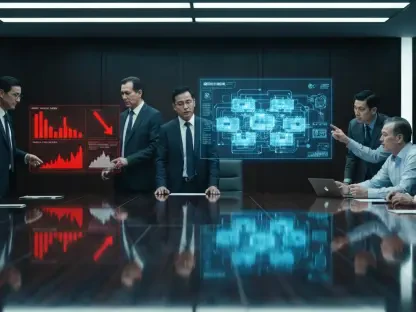The United States has recently introduced sweeping new export controls on certain critical technologies, notably semiconductors and quantum computing items. These measures are part of a strategic move by the Department of Commerce aimed at bolstering national security and mitigating foreign policy risks, primarily concerning China’s aggressive technological ambitions and Russia’s ongoing military activities. The newly implemented export controls signal a significant shift in the US strategy to manage and control the global distribution of advanced technologies, reflecting broader concerns over geopolitical stability and technological supremacy.
New Export Controls: Safeguarding National Security
The latest US export controls specifically target sophisticated technologies that are deemed crucial for national security. These include semiconductor manufacturing equipment and advanced quantum computing systems. By restricting access to these technologies, the United States aims to prevent adversarial nations from using them to enhance their military capabilities or gain a strategic edge. The restrictions are a part of a broader effort to curtail the proliferation of dual-use technologies—those that have both civilian and military applications.
The newly formulated rules by the Department of Commerce are particularly focused on addressing the rapid technological advancements pursued by nations such as China. There is a growing concern in Washington regarding China’s Military-Civil Fusion strategy, which seeks to integrate civilian technological advancements into the military sector. Through tightening these export controls, the US hopes to limit China’s access to the most advanced tools and technologies that could be leveraged to bolster its military infrastructure.
China’s aggressive pursuit of advanced technologies presents a unique challenge for the US and its allies. The Military-Civil Fusion strategy underscores a concerted effort to leverage civilian technological innovations for military purposes, complicating the ability to differentiate between civilian and military end-users when exporting critical technologies. Meanwhile, Russia’s approach to acquiring these technologies differs significantly. Instead of developing its own advanced tech domestically, Russia often relies on illicit means to procure necessary components for its military operations. This has become particularly evident in the context of Russia’s activities in Ukraine, where the need for modern military equipment has driven the country to seek out black-market avenues for critical technologies.
Challenges Posed by Emerging Technological Threats
The landscape of technological threats is rapidly evolving, making it imperative for the United States to stay ahead of potential adversaries. China’s Military-Civil Fusion strategy exemplifies its aggressive pursuit of advanced technologies to integrate civilian innovations into its military framework. This strategic move complicates efforts by the US and its allies to identify and control the flow of sensitive technologies effectively. The newly introduced export controls aim to create clearer boundaries and ensure that sensitive technologies do not fall into the wrong hands.
Conversely, Russia adopts a different approach to acquiring advanced technologies, relying predominantly on illicit means rather than domestic innovation. This is particularly evident in the context of its military activities in Ukraine, where its reliance on modern military equipment has driven the country to utilize black-market avenues. The US’s export controls are strategically designed to disrupt these channels and limit Russia’s access to high-tech military components. By tightening export restrictions, the US aims to impede Russia’s ability to procure these essential technologies, thereby hampering its military operations.
The distinction between China’s and Russia’s strategies underscores the diverse challenges faced by the United States in securing critical technologies. As these technological threats continue to emerge, the US must adapt its strategies to ensure its technological supremacy and safeguard national security effectively. The introduction of stringent export controls is a proactive measure toward addressing these evolving threats and maintaining a strategic edge in global technological advancements.
The Role of Multilateral Export Control Regimes
Historically, multilateral export control regimes have been pivotal in regulating the distribution of sensitive technologies across borders. Key frameworks such as the Nuclear Suppliers Group (NSG), the Missile Technology Control Regime (MTCR), the Australia Group, and the Wassenaar Arrangement have played an essential role in fostering international cooperation and ensuring that export controls are applied consistently among different countries. These regimes are inherently country-agnostic, focusing instead on controlling the flow of military and dual-use technologies globally to maintain international security.
Despite their historical significance, the effectiveness of these multilateral regimes has been increasingly called into question. The rapidly changing technological landscape, coupled with the specific threats posed by nations such as China and Russia, has exposed significant weaknesses in the current frameworks. For example, Russia’s involvement in most of these regimes has hindered progress, particularly in updating the Wassenaar Arrangement, which governs dual-use technologies. There’s a growing consensus among policymakers and experts that these regimes need substantial reform to address contemporary challenges more effectively.
The limitations of these multilateral frameworks have led to a broader discussion about their adaptability to the current global security environment. The rigid structures and country-agnostic nature of these regimes struggle to keep pace with the dynamic and specific threats posed by emerging technological advancements. As these frameworks are increasingly seen as insufficient, there is a pressing need to reform or establish new multilateral mechanisms that are more agile and adaptable to contemporary geopolitical challenges.
National Actions and Unilateral Controls
Given the inadequacies of multilateral regimes, the United States and its allies have progressively turned towards implementing unilateral controls over critical technologies. The US has collaborated with nations such as the Netherlands and Japan to impose stringent export controls on semiconductor manufacturing technology and other advanced areas. These efforts are aligned with a broader strategy to reshape global supply chains and restrict China’s access to cutting-edge technologies that could potentially enhance its military capabilities.
This shift towards unilateral actions underscores the urgency felt by the United States and its partners in addressing the technological ascent of China and the dangers posed by Russian procurement activities. The “consensus minus one” approach has emerged as a practical solution, enabling countries to implement national controls on technologies even if they are not universally agreed upon within existing multilateral frameworks. This approach ensures that critical technologies are safeguarded despite the lack of consensus within international regimes, allowing for a more targeted response to specific threats.
The unilateral actions taken by the United States and its allies reflect a strategic pivot towards securing national interests through direct and immediate measures. While multilateral agreements provide a platform for international cooperation, unilateral controls offer a more agile and responsive mechanism to address the rapid advancements in technology and the associated risks. This dual approach—leveraging both multilateral cooperation and national controls—aims to create a more comprehensive and robust framework for managing the global distribution of advanced technologies.
The Push for Multilateral Reform
The United States recently enacted sweeping export controls targeting key technologies, such as semiconductors and quantum computing equipment. Spearheaded by the Department of Commerce, these measures aim to enhance national security and mitigate foreign policy risks, particularly addressing concerns over China’s assertive technological advancements and Russia’s military activities. The new export controls signify a fundamental shift in how the US manages the global distribution of advanced technologies. By restricting exports, the US hopes to curb the potential misuse of critical tech by rival nations, thereby maintaining a strategic edge. These actions reflect broader apprehensions regarding geopolitical stability and maintaining technological supremacy. The controls are designed to protect sensitive technological innovations from ending up in the hands of countries that could use them against US interests. In essence, this move underscores a growing determination within the US to safeguard its technological leadership and ensure that such critical assets do not contribute to the military or strategic capabilities of potential adversaries.








